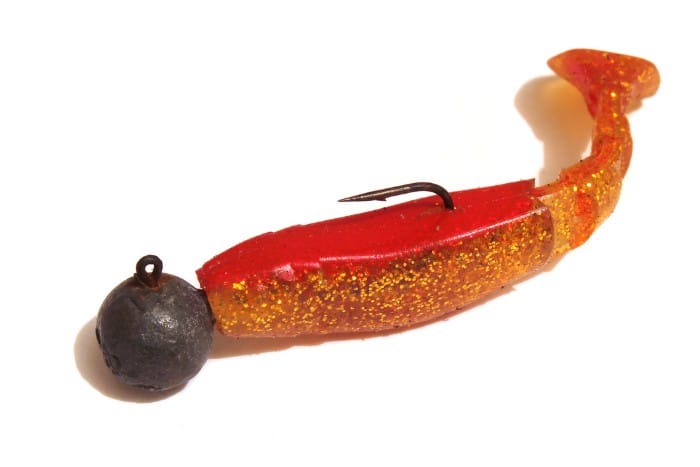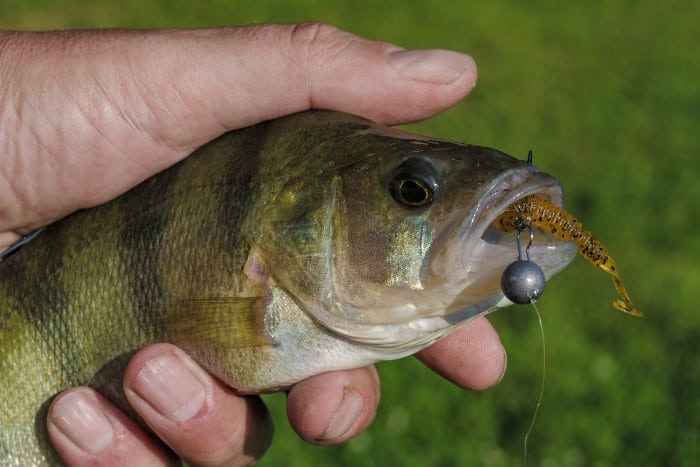There are a few primary ways anglers target fish through the ice: jigging, tip-up fishing, spearfishing, and dead sticking. Each ice fishing has its own unique variations that anglers need to master in order to land fish through the ice. However, jigging is one of the most productive of all the techniques.
To jig in ice fishing, anglers need to let their bait sink to the bottom, slowly raise it around a foot, and then use their hand and wrist to complete the jigging process. Small flicks of the wrist will give the bait the necessary action needed to attract the fish in the area.
If you can understand the ins and outs of jigging, you’ll give yourself a great chance of catching a high number of fish through the ice.
How To Hold Your Rod and Reel for Jigging?
The way you hold your ice fishing rod is a bit different than you would hold an open water spinning rod and reel. You want as much control of the rod as possible when ice fishing.
You also want to feel every single nibble on your bait, so you can set the hook before the fish drops the bait.
You want to hold your rod at the base of your reel. Use your thumb and pointer finger and wrap them around the reel base. The butt of the rod will then sit on top of your hand.
By holding the rod with your pointer finger and thumb, you’ll be able to quickly flick your wrist up and down and feel any sort of strike that occurs.
Jigging Techniques
There are a variety of different techniques anglers are able to use to jig and create movement on their bait.
There isn’t one single method that’s going to attract fish best, so having a few different ways to jig will give you an even better chance to attract fish to your jig.
1. “The Soaker”
The most straightforward “jigging” technique is dropping your bait to where you see the fish on the fish finder and letting it sit among them.
As long as you have some bait attached to your jig, you’ll likely find that fish will strike. It helps to use a small, size 8 or 10 jig if you use the soaker method.
Any current will create action on the jig and bait, so you don’t have to make any moves with your rod. As soon as you see fish moving towards your bait, you can raise the jig and see if fish follow.
If they follow, let it sit, and you’ll likely get a strike. If fish are striking on the “soaker” method, you know they’re hungry, so you’ll probably have a productive day on the water.

2. “The Drop”
The drop is the most popular type of jigging method. When your jig is in the desired location, raise your arm or flick your wrist up and let the jig fall again.
These movements let the fish in the area know that something is available that they would likely want to eat.
Depending on the fish you’re targeting, and where you’re fishing, you may have to vary how large of movements you make with your wrist or arm.
If you’re fishing for panfish, a few flicks of your wrist should be enough movement for them to strike.
If you’re going after lake trout or other larger fish, you may have to raise your arm one or two feet at a time. More significant movements are the type of action they want to see.
Don’t be afraid to incorporate some of the smaller twitches, but it’s best to stick with larger jigs. Don’t be married to one method!
3. Swim Your Jig
The swimming technique is another good choice if you’re going after fish requiring extra movement. To “swim” your jig, you need to pull your rod tip side-to-side.
As you’re moving it side-to-side, don’t be afraid to make a few upward pulls. The upward draws will give your jig even more action.
More action can work in your favor when going after those sluggish fish that need to be convinced.
Obviously, ice holes don’t give you much room to pull your bait side-to-side, so some anglers drill two holes in one to provide them with more room to move around their bait.
Plus, if you hook a large fish, the two holes give you more room to land it. This swimming method is excellent for walleye or lake trout.
Walleye and lake trout are used to seeing their bait move around, so if you aren’t able to accomplish this, you may struggle to land the amount of fish you want.
4. The Gentle Jig
Some days, the fish are going to be extra finicky. You’ve found out that they aren’t responsive to quick and jerky movements and don’t want bait that’s still.
The “gentle jig” is a method that can help you fill that void. A gentle jig doesn’t only have to be small up and down movements of your rod tip. They can be longer.
The important thing to remember is not to be too jerky and don’t go too fast. Slow jigs with pauses at the top or bottom are the most effective.
Take your time and let the bait and jig do the work. Your small movements are plenty. The gentle jig method is especially effective in the midst of a cold snap.
Fish may be less than eager to eat because of a drop in temperature. Fish are still hungry during cold snaps, but their energy levels and metabolisms are extremely slow.
You must keep that knowledge in mind and meet the fish where they are. Slow and steady generally wins the race in these conditions.

5. Free For All
The last option anglers have when they’re jigging is what is called the “free for all.” When you’ve tried all the methods mentioned above, feel free to combine them into one process.
You can try quick jerks up with slow drops and pauses. You could also lift your jig slowly, quickly drop it and give it a few jerks along the way.
What many anglers choose to do when they don’t exactly know what the fish want is a foot or so raise of the jig and drop it one or two inches at a time and let it pause.
Fish like to hit the bait as it’s falling or paused. Some anglers will also use the side-to-side jigging method with elongated drops and raises of the jig.
The side-to-side action is an underused technique, so fish generally are receptive to it. Fish are temperamental, and there’s no exact science on how to best get them to strike.
Take your time and experiment with a variety of different jigging methods, and you’ll eventually find one that is going to work for you.
Conclusion
At the end of the day, jigging is one of the most effective ways to catch fish through the ice. Fish flock towards a flashy jig or spoon, bouncing up and down in the water.
They become especially effective when they’re tipped with a worm or a minnow head.
Do your best to master one of the abovementioned jigging methods, and you’ll give yourself a chance against any type of fish.
You’ll have confidence that you can make the most of your time on the water regardless of how the fish are feeding.
